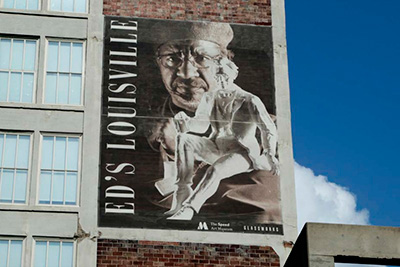A photograph of Frost in her studio. Photo by Sarah Katherine Davis For LVA (2016),
Artists often talk about their relation ship to materials or medium. These revelations strike at the heart of why they make art at all, expressing the universality of creation through the very specific terms of their own process. Lindsay Frost works with wood, taking a material that begins as monumental and nearly unyielding and fashioning objects of great delicacy.
“My art is very personal to me,” explains Frost, “…and I want to share it with those who have never really looked at the inside of a tree the way I do. There is an amazing inner beauty hidden inside a tree. The containers I create reveal the grain and color, the different funguses, all the unique properties that are hidden from man inside a tree.”
An inside look at Lindsay Frost's studio. Photo by Sarah Katherine Davis For LVA (2016).
"#458 (Footed Tulip Poplar Bowl)" by Lindsay Frost, wood, 4x5in (2016)
The reverence for trees as both a form and a living entity that not only shares the earth with humankind and is essential for our very existence is a deeply spiritual sentiment that belongs to history. “That is what I try to do, to release that inner spirit so the wood can again please man. Each piece tells a tale, of the struggles in growth, success in reaching the sun, imperfections from lightning and insects, drought and fire.“
You can visit Lindsay Frost in her studio on the east side of Louisville during OPEN STUDIO WEEKEND, November 5 & 6, 2016. The event benefits scholarship programs for Louisville Visual Art and University of Louisville’s Hite Art Institute and tickets may be purchased here. She will also be a part of Art for the Senses in Jeffersontown, KY on November 11.
Hometown: Manitowish Waters, WI, but now Louisville, KY
Education: BA in Art from Lindenwood University, St. Charles, MO.
Website: http://www.lindsayefrost.com
FaceBook: http://www.facebook.com/LindsayEFrost
Gallery Representation: Edenside Gallery in Louisville & Berea Artisans Center in Berea, KY.
"Meditation Bowls" by Lindsay Forst, wood, approximately 3x1.5in, $22
"Acorn/Lichen Buttons" by Lidsay Frost, wood, 3/4 to 1in D. x 1/4in, $4.00each
Are you interested in being on Artebella? Click here to learn more.
Written by Keith Waits. Entire contents copyright © 2016 Louisville Visual Art. All rights reserved.
Please contact josh@louisvillevisualart.org for further information on advertising through Artebella.




















